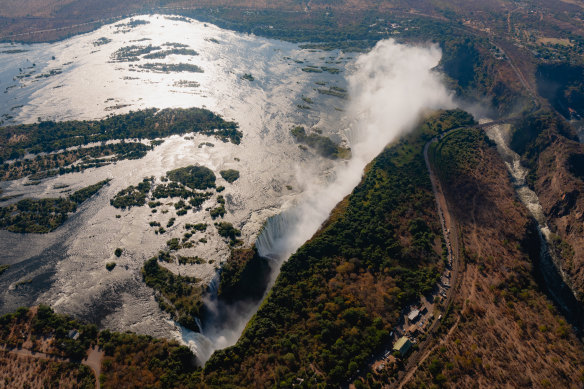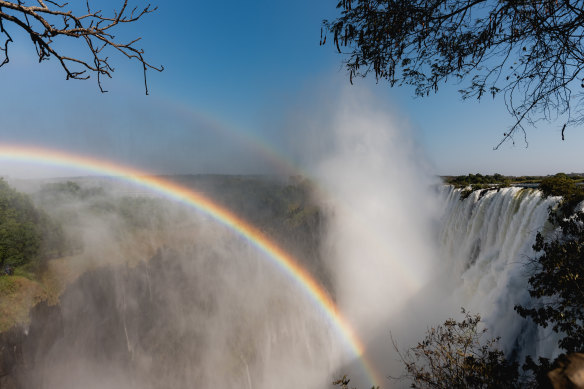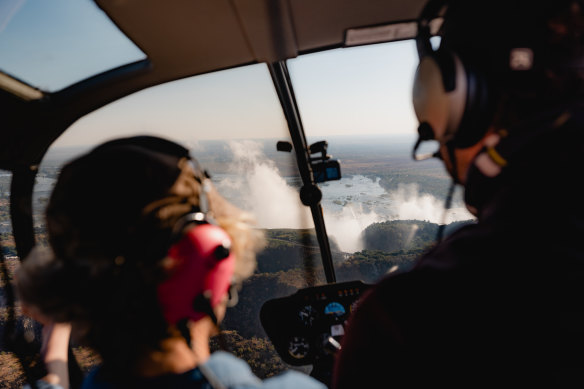A flight over this spectacular natural wonder is heavenly
The brochure’s promotional spin promises “The Flight of Angels”. I’m rather taken by this lofty description of a helicopter journey over Victoria Falls, if sceptical about its claims which border on the religious. But perhaps it’s not surprising.

David Livingstone called the view so lovely that it “must have been gazed upon by angels in their flight”.
It was Scottish missionary and explorer David Livingstone who in 1855, on spotting the falls after journeying in a dug-out canoe along the Zambezi River, gushed in his diaries: “… scenes so lovely must have been gazed upon by angels in their flight”. With this sentiment, he renamed the falls after his monarch, Queen Victoria, (more on the traditional name later).
These days, visitors can visit different sections of the 1708 metre-wide falls – one of “Seven Natural Wonders of the World” – from both Zambia and Zimbabwe. The deafening roar, soaking spray and perfect rainbows that arc over a mass of green of an indigenous rainforest provide a natural extravaganza at eye level. But I’m taking a different angle.
I’m boarding a helicopter for a 30-minute bird’s-eye encounter of this spectacle. Intuitively, I duck my head to avoid the blades that emit a fierce chop-chop-chop. The voice of Grant Welch, the pilot, comes through our bright pink ear phones: “Be aware. It gets windy so don’t stick your smartphone out the window”. With that brief warning, we take off.
The helicopter rises, hovers, shudders slightly and tilts forward. I grasp the meaning of stomach lurch: my gut has remained back at base. It catches up seconds later. I didn’t anticipate this. I berate myself for over-indulging in my breakfast: scrambled eggs, freshly made muffins and fruit, prepared by the chefs at Sussi & Chuma Lodge.
It’s a relief when the aircraft levels out. Welch points out a herd of eight elephants, from aerial heights they resemble massive boulders. It’s a mere prelude. A minute later, we’re gliding over the magnificent Zambezi River that shimmers below like a giant icefield.

Victoria Falls ... “deafening roar, soaking spray and perfect rainbows”.
But the real show-stopper is an iridescent white blanket that billows upwards, like steam seeping through a giant crack in the Earth. This extraordinary vision gives rise to the traditional (and far more powerful) Lozi name: Mosi-oa-Tunya. Smoke that Thunders. It’s a perfect description for the voluminous spray, resulting from roughly 500 million litres of water that plunge every minute over a basalt plateau into a 108-metre high chasm. Between the months of April and June when the river is at its peak, the mist can be seen from up to 50 kilometres away.
It’s hard to believe that the source of the incredible 2700-kilometre Zambezi River, a lifeline to communities and animals, is a mere spring in Zambia’s northwest. The falls are the half-way point along the river that flows through eastern Angola, before touching on Namibia and Botswana. It forms the border between Zambia and Zimbabwe and finally crosses Mozambique to enter the Indian Ocean.
From our heights, the thick spray hides the falls’ five sections along its precipice, natural delineations caused by recesses and small islands: The Devil’s Cataract, Main Falls, Horseshoe Falls, Rainbow Falls, and the Eastern Cataract. Instead, we have a clear birds’ eye view of another wonder: six or so gorges that zig-zag back and forth, nature’s remarkable switchback created by the pounding of water over hundreds of thousands of years.

View to a thrill.
We pass over Victoria Falls Bridge, a steel-arched structure built in 1905 across the second gorge, and links Zambia and Zimbabwe. (I discover only later that Sir Ralph Freeman, a British civil engineer involved in the project, was one of the designers of the Sydney Harbour Bridge).
“Time for Batoka Gorge?” suggests Welch. We drop suddenly and swoop, in James-Bond-on-a-chase mode, through a narrow chasm. Its walls race past and white waters churn below. We skim over the rapids before arcing upwards to emerge into the clear sky, blinking.
The helicopter circles and, to our delight, we return the same way. This time I record the journey on my phone.
But no footage can capture the flight’s thrill: the wind, speed and vistas.
It’s back to the airstrip where we descend deftly onto the landing pad. So overcome by the flight, I don’t utter a word the entire journey.
And as I clamber out of the helicopter, I say thanks for this glorious experience. And to the angels, too.
Dr Livingstone, I presume?
This year, 2023, marks the 150th anniversary of Dr Livingstone’s death. Born in Scotland in humble circumstances, Livingstone became a doctor, missionary (taking a stance against slavery) and explorer, leading trips throughout Central and East Africa.
In 1871, Henry Morton Stanley, another British explorer, greeted Livingstone (by then considered missing) with the phrase: “Dr Livingstone, I presume?” While to date, history has generally judged Livingstone kindly (including among the Zambian people who named a town after him), it’s not without criticism, especially given colonial era practices and attitudes. In 2011, researchers used spectral imaging technology to analyse an illegible diary and claimed that he may have covered up his involvement in a massacre.
In Zambia, the Livingstone Museum pays homage to their hero through his personal relics and descriptions of his achievements. Sussi & Chuma, after which Abercrombie & Kent named a lodge, were Livingstone’s companions and accompanied his body back to Britain after his death in present-day Zambia. He died aged 60 on May 4, 1873, from malaria and dysentery.
THE DETAILS
STAY
Two-night stays at Sussi & Chuma Lodge are included in Abercrombie & Kent’s “Botswana Safari in Style” itinerary. From $15,130 a person. The itinerary includes a visit to Mosi-oa-Tunya/Victoria Falls from both the Zimbabwean and Zambia sides.
Helicopter rides are offered by A&K’s Sussi & Chuma Lodge From $US195 a person
MORE
Kate Armstrong was a guest of Abercrombie & Kent.
Sign up for the Traveller Deals newsletter
Get exclusive travel deals delivered straight to your inbox. Sign up now.